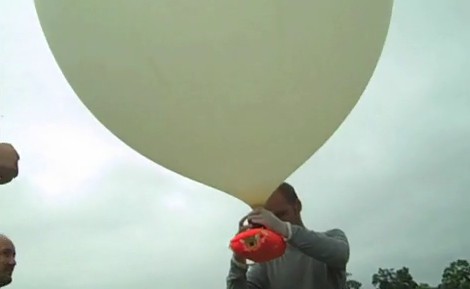[Luke Geissbuhler] wanted to send something into space, a fun project his kids could get in on too. Instead of sending up a suite of electronic components they went with consumer electronics. The key element, an HD camera to record the event, is protected by a styrofoam shell and soft foam padding. To help ensure that the device was recovered an iPhone also made the trip, running a GPS tracking program that continuously updated the package’s location. To combat the ill-effects of severe cold some chemical hand warming packs also joined the flight.
As you can see after the break, it was a success. The camera documented an incredible ride, with a balloon rupture at 19 miles above the earth (that must be a calculated height as there’s no altimeter in the package). The pod came down gently thanks to a parachute and was recovered just 30 miles from where it launched.
[vimeo=http://vimeo.com/15091562]
[Thanks Ferdinand via Flabber]
















I’ve been launching weather balloons with radiosondes attached as part of a yearly demonstration at my kids’ school when one of the classes hits the “weather” unit in their science class. (I used to be a meteorologist before I changed careers.)
I’m thinking, though, that next year’s demonstration should have a slow-scan television transmitter payload. I do have my amateur radio technician’s license, and I can probably get ,y general before spring. Anybody have any opinions on that?
Matbed says “15KMs or 500 M/S” and lwatcdr uses “under 900 knts” after a mention of 60 K feet of elevation. Is that a speed as in 900 knots? I am astonished at the poor level of English usage and spelling in so many posts by electrogeeks. I find the arrogance of so many stereo, computer and elex geeks to be extremely annoying. When I see a snotty 17 yr old tub of goo who can trace circuitry in his head rhapsodize about some ‘game’ while stinking up the room from weeks sans bath, I know somebody goofed in his upbringing.
That was fucking amazing.
Wow! Amazing! Congratulations for your first spaceflight!
Marco
There is a dutch guy who did this too. He’s a university student in holland. You can find his site here: http://hollandshoogte.wordpress.com/
and that includes his video’s and pictures.
He started building his own PCB’s for the flightdata, and he might even release it to the general public someday. You can find quite a lot off info on his site.
Dear Dave Stanford,
Calm down.
<3
Ben
@Dave Stanford:
So you complain about the “poor level of English usage” by others while showing no reluctance to demonstrate your own inability to convert from knots to meters per second. I guess you are an English major at Stanford, right?
Space is so awesome :)
We have done this a couple of times. Check out our videos at: http://www.youtube.com/watch?v=jvMurntaHos. Each time we evaluate our craft and make improvements and additions.
Ah! Congratulations on your success, well done. That was a joy to watch, thank you.
Mike:)
my first words where “WOW”
I love it, though 1 thing I am upset about is it did not capture a ufo flying by, now that would of made my day.
Great project.
http://www.youtube.com/watch?v=dEFy0-pThlM
I worked on a launch similar to this recently for a music video. We launched from outback Australia. Condensation was our biggest issue, as the outback is not very dry at the moment.
some behind the scenes at: http://www.youtube.com/watch?v=B6SXL2d3IlY
I want to know what the electronic rhythm was!!!! I can’t find info anywhere as to what it could be
Wow it’s amazing ! i just want to do same program in France !
@D.ank
A coded subspace message from a Klingon vessel… or more likely electromagnetic radiation from a terrestrial or extraterrestrial source causing interference in the audio circuit. I didn’t see any shielding, and that would have been contraindicated by the use of GPS and cellular signals, unless the antennas were externalized from the shielding. Any length of wire, PCB trace, or even pins on components can become antennas for particular wavelengths, as well as other items. All you need is enough energy in that wavelength. At these altitudes, the device would be subject to a lot of interesting effects.
Sadly I can never do this. Being in New Zealand the chances of the module landing somewhere in the sea (or in Australia :) are pretty high..
Is this America now? Criticize everything while we rot on our own posteriors?
The article is awesome, the project is awesome. If you don’t think so, do one better and get it posted on your own widely read blog- unless of course you can’t handle it, the most likely case.
p.s. the FAA is so grossly incompetent I think not telling them would probably be safer.